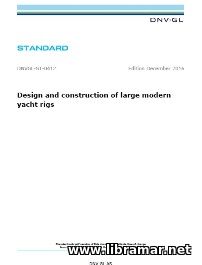 The requirements of the present DNV GL standard shall apply to the sailing yachts having a length exceeding twenty-four meters. The main scope of the document is the structural integrity of the Bermudian rigged mono- or multihull yachts having one or more masts with the spars manufactured either of CRP, standing for the carbon fiber reinforced plastics, or from aluminum alloys; this includes dimensioning of the rigging, mast/boom sections and local construction around fittings.
The publication covers the verification and certification systematics including general procedures and technical documentation involved, and major principles of design and construction including determination of the rig loads and working loads and local and global analysis. A separate chapter has been devoted to the materials and fabrication. The rest of the volume addresses the rigging itself, fitting and equipment, their maintenance, coating and corrosion protection, lightning protection, pre-delivery inspection and many other issues considered important for the design and construction of rigging for the above mentioned types of sailing yachts. The associated documentation is dealt with in the appendix.
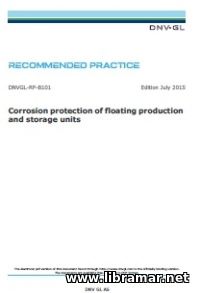 The document contains guidelines issued by DNV GL classification society related to the corrosion protection of FPS, i.e. floating production and storage units. Looking from the corrosion protection perspective, these units differ from the conventional vessel in the sense that they do not dry dock on the regular basis. The units are in continuous operation throughout their service lives.
That is why the cathodic protection system and coating systems of these units shall be extended for more than ten years to provide required degree of hull protection. The main goal of this recommended practice is to achieve a service life while minimizing the maintenance during service. This can be done by combining the coating with the CP, i.e. cathodic protection systems.
Such approach will give several advantages, for example even current distribution, reduced total cathodic protection current demand, which will result in the weight of sacrificial anodes significantly reduced, rapid polarization to the protective potential etc. Note that we also have another recommended practice which is dealing with the protection of submarine pipelines from corrosion. The document also contains coating tables.
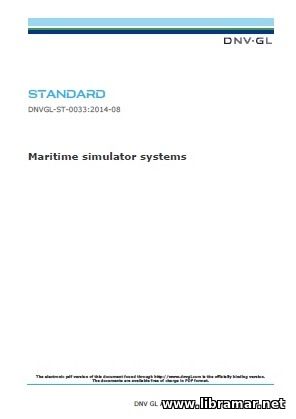 The present DNV standard was developed with the intention to give necessary requirements that would apply to the performance of various maritime simulator systems; the STCW convention requires that such simulators, when they are used either for mandatory simulator-based training, or as a mean to demonstrate assessment/competence, or to show continued proficiency required by the same convention, are subject to approval by the relevant maritime administration, in accordance wit the Reg. 1/12 of STCW convention.
This DNV standard hereby proposes one of the ways of carrying out above noted approval. Its purpose is to ensure that the simulations which have been provided by the maritime simulator include an appropriate level of behavioral as well as physical realism, as per the assessment and training objectives. The publication starts with a list of changes, followed by the application and certification information defining the scope of certification and listing the documentation.
The next part provides the overview of the maritime simulator equipment and instructor/assessor facilities; the other parts of the booklet address bridge and machinery operation, radio communication, handling of dry and liquid cargoes, ballast handling, safety and security, dynamic positioning, VTS operation, operation of the survival craft and rescue boat, operation of the offshore crane and ROV.
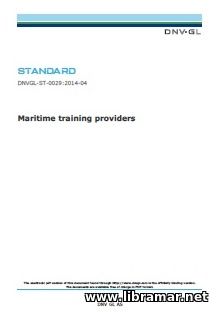 This standard has been developed and released by DNV GL classification society with the intention to provide all necessary requirements for training providers within both offshore and maritime field, and offer academic and vocational training/education, leading to the issuance of associated certificates ensuring the quality of development and delivery of training programs and training courses.
It shall be applied to all providers of maritime and/or offshore training who develop the educational programs and offer training courses and programs. Training providers fully complying with all requirements that are stated within this standard may be considered certified for the relevant type of service they offer, and issued the certificate - this may be maritime academy or maritime and/or offshore training center, maritime and/or offshore simulation center etc.
Such certification would include thorough assessment of the relevant documents of the provider's management system and implementation audit, followed by the annual and renewal audit of the training providers. The very first section of the booklet gives info on the application and certification, followed by some general information. The other three sections cover planning, development, preparation, operation and result phases.
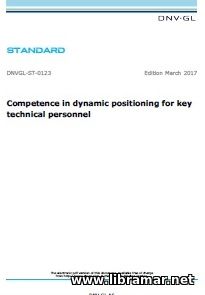 The objective of the present official DNV GL standard is to duly state the expected level of the competence and awareness of the technical personnel being assigned wither watchkeeping or routine maintenance and repair works on the systems that may affect dynamic positioning integrity of the ship or offshore installation.
The document aims to provide all required guidance to establish a competence foundation via a set of related competencies as well as awareness level for the key personnel including engine room watchkeepers, engineers, and shore-based support staff. Noting that there are so many different systems available today, it is considered critically importance for the above stated personnel to have due technical knowledge and good understanding that can be applied to the procedures and systems on board.
Subject competencies should be developed through technical training approved by the manufacturer. The content of the standard can be used as a reference source for familiarization or assessment of the people and as a guidance to the providers of training developing the courses as required by the standard and demands of the industry. The introduction to the document provides the information about the professional profile and required performance standard while the main content addresses the taxonomy and competence requirements.
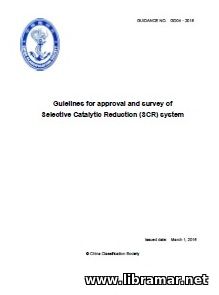 The present official China Register Guidelines are intended to apply to the SCR, standing for the selective catalytic reduction systems that are installed to reduce the emission of NOx from the shipboard diesel engines. they stipulate all applicable class requirements for the design and onboard arrangement, control and monitoring, and post-installation testing of these systems.
Note that the content of the Guidelines does not include detailed requirements for the product inspection and type approval of the SCR systems. They are rather supplementing current CCS Rules and the systems shall comply with all relevant requirements of the rules. The Guidelines shall be applicable to the CSR systems with reductant using either aqueous ammonia or urea solution.
It shall be taken into account that special consideration and approval shall be there for the systems using liquid ammonia. The intent of the Guidebook is to provide necessary standards for these systems; compliance with subject standards will allow to minimize the potential harm to the vessel, crew members and environment. All functional requirements stated in the Guidelines shall be complied with in order to achieve this goal...
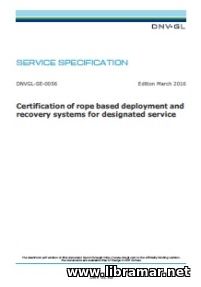 The official DNV GL service specification providing requirements for the certification of the rope-based deployment/recovery systems. The document contains all procedural requirements that shall be referred to when obtaining/retaining certificates as well as other statements.
The above mentioned certification would normally consist of certification of system integration and designated service. The document opens with short introduction providing information about the scope and objective of the specification, basis for certification and definitions.
The main part of the document provides certification requirements for the designated service including certification process and deliverables, and system integration, and of component systems covering fiber ropes, hybrid and steel wire ropes, positioning, winching, control and power systems, monitoring and finally condition management systems as well as other software.
Two appendices at the end of the volume provide additional information about the technology assurance including qualification management, and associated services such as the marine warranty surveys conducted by this classification society.
 These CCS guidelines shall be applicable to the stationary FCP, i.e. fuel cell power systems that use hydrogen or natural gas as fuel on seagoing vessels. The fuel mentioned above is commonly stored onboard in either liquid or gaseous state. The vessels provided with subject systems shall comply not only with the provisions of this guidebook but also with the requirements stated in other CCS Rules, as applicable.
The document covers the arrangements including general provisions, cell spaces,. storage tanks and pump/compressor rooms. The section of the volume devoted to the fuel systems addresses piping in the gas-safe cell spaces and outside such spaces, fuel bunkering systems and ESD-protected areas. Then the section goes dealing with the fire fighting and covering fire extinction, detection and alarm, ventilation and structural fire protection.
The rest of the book deals with the explosion protection including classification of the hazardous areas, control and monitoring systems, safety systems, and list some additional requirements applicable to the vessels assigned associated class notation. A separate section is there addressing the survey and testing activities covering surveys both during and after construction.
« 1 2 ... 14 15 16 17 18 ... 29 30 » |







